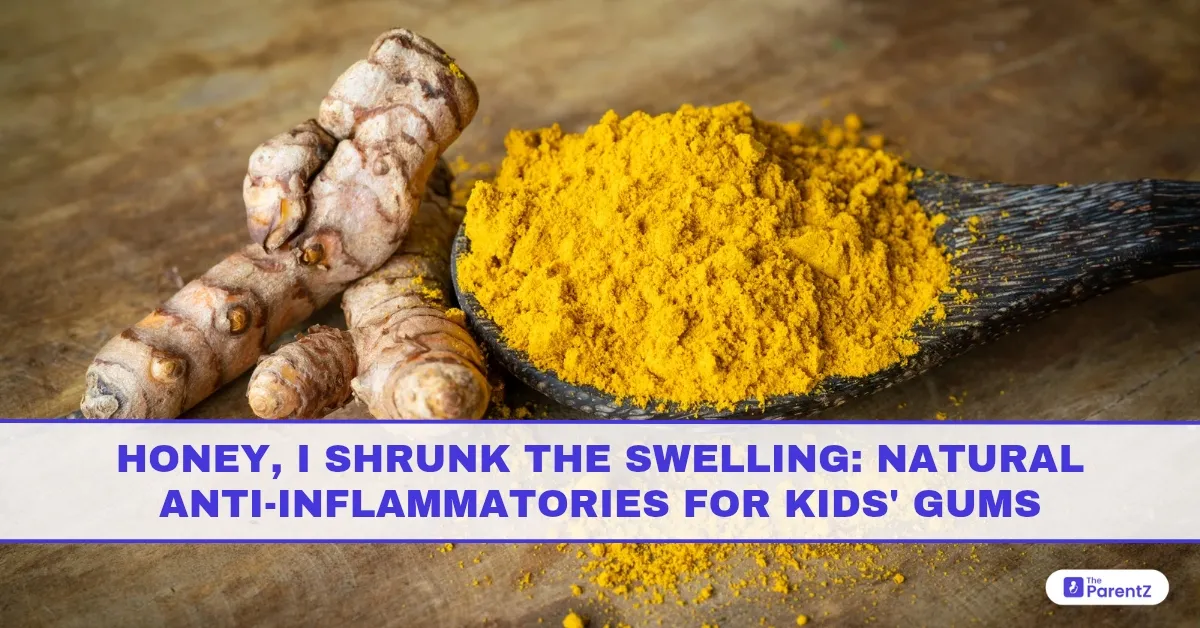Swollen, red, or irritated gums in children are surprisingly common. Whether it’s teething in babies, food stuck between teeth, or early signs of gingivitis in older kids, gum inflammation can cause discomfort and concern.
While a trip to the dentist is sometimes necessary, many cases of mild gum swelling can be soothed at home with natural, kid-safe anti-inflammatories. The key is knowing which remedies are safe, gentle, and backed by science, and when it’s time to stop DYing and call your pediatric dentist.
In this article, we explore the best natural remedies for swollen gums in children, including when and how to use them safely, and red flags you shouldn’t ignore.
What Causes Swollen Gums in Children?
Understanding the root cause helps in choosing the right treatment. Common culprits include:
- Teething (in babies and toddlers)
- Food debris or plaque buildup
- Gingivitis (early gum disease, often due to poor brushing)
- Mouth ulcers or canker sores
- Vitamin C deficiency (rare, but possible)
- Irritation from dental appliances (like braces or retainers)
Most of these cases are mild and reversible with consistent oral hygiene and supportive home care.
Top Natural Anti-Inflammatories for Kids’ Gums
These remedies are chosen for their safety profile, ease of use, and evidence of effectiveness in reducing gum inflammation—especially in pediatric settings.
1. Cold Compress or Chilled Spoon
Best for: Teething, minor irritation
How it helps: Cold numbs pain, reduces swelling, and soothes inflamed tissues.
How to use:
Wrap a clean cloth around ice cubes or chill a metal spoon and gently press it against the gum area for 30–60 seconds.
Safe for babies and toddlers (under supervision)
Avoid using ice directly on baby gums—it’s too harsh.
2. Chamomile Tea Rinse or Compress
Best for: Older kids with mild gum irritation or mouth sores
How it helps: Chamomile is a natural anti-inflammatory and antimicrobial.
How to use:
Brew a weak chamomile tea, let it cool, and use it:
- As a warm compress (dabbed gently on gums)
- As a gentle mouth rinse (for kids over 5 who can swish safely)
Chamomile has a calming effect—also helps with bedtime fussiness if gums hurt.
3. Clove Oil (Diluted)
Best for: Short-term relief from teething or gum pain in older children
How it helps: Clove contains eugenol, a compound with proven anti-inflammatory and analgesic effects.
How to use:
Mix 1 drop of clove oil with 1 tablespoon of coconut oil. Dab a tiny amount on the affected gum with a clean finger or cotton swab.
Do NOT use clove oil undiluted or in large amounts.
Avoid infants under 2—it’s too strong.
4. Salt Water Rinse
Best for: Mild gum swelling from trapped food or early gingivitis
How it helps: Salt is a natural disinfectant that can reduce inflammation and bacteria.
How to use:
Dissolve ½ teaspoon of salt in a cup of warm water. Let your child rinse for 30 seconds and spit. Use 1–2 times daily.
Only for children over 5 who can rinse and spit properly.
5. Turmeric Paste
Best for: Older children with localized swelling or canker sores
How it helps: Curcumin in turmeric has anti-inflammatory and antibacterial properties.
How to use:
Mix a pinch of turmeric with coconut oil to form a paste. Apply gently on swollen gums and leave for a few minutes before rinsing.
Some studies show turmeric is as effective as chlorhexidine in mild gingivitis.
Don’t use on open wounds or ulcers without consulting a dentist.
6. Aloe Vera Gel (Natural, Edible)
Best for: Irritated, dry, or swollen gums
How it helps: Aloe has soothing, healing, and anti-inflammatory effects.
How to use:
Use a pure, edible aloe vera gel (check label). Dab on the affected gum with a clean finger.
Safe for older kids if not swallowed in large quantities
Avoid supermarket gels with added preservatives or alcohol.
Bonus: Anti-Inflammatory Diet for Gum Health
Nutrition plays a key role in reducing chronic gum inflammation.
Include:
- Fresh fruits and veggies (especially vitamin C-rich ones like oranges, guavas, and amla)
- Omega-3s (flaxseed, chia, or walnuts)
- Probiotic foods (curd/yogurt)
- Water-rich foods (cucumbers, melons) to maintain saliva flow
Avoid: Sugary snacks, juices, processed foods, and acidic candies—all irritate gums and fuel bacteria.
When to Stop Home Remedies and Call the Dentist
While natural remedies are great for minor issues, they’re not a cure-all. Seek professional help if:
- Swelling lasts more than 3–5 days
- Gums bleed frequently while brushing
- There’s visible pus, abscess, or bad breath
- Child has pain while eating or speaking
- Gum overgrowth, ulcers, or tissue discoloration is visible
- Your child has fever or facial swelling (urgent)
If in doubt, always err on the side of caution. Pediatric dentists are trained to spot problems early and are gentle with kids!
Pediatric Dentist Says…
“Natural remedies are great for supportive care, but they don’t replace a thorough dental cleaning or diagnosis. If inflammation keeps coming back, it’s usually a sign that brushing technique, plaque control, or overall dental hygiene needs support.”
— Dr. Neha Sharma, Pediatric Dentist, Mumbai
Involving Your Child in the Process
Making gum care fun encourages cooperation:
- Let them choose their “soothing spoon” or help make turmeric paste
- Use picture books to explain sore gums
- Give a “Super Smile” sticker after each remedy session
Conclusion
Swollen gums in kids are usually manageable, especially when caught early. With the right blend of natural anti-inflammatory remedies and good oral hygiene, you can soothe discomfort while supporting your child’s long-term dental health. Just remember—if something doesn’t improve or seems unusual, your dentist is your best ally.
So next time your child says, “My gums hurt!” you’ll know exactly when to reach for the clove oil and when to reach for the phone.








Be the first one to comment on this story.